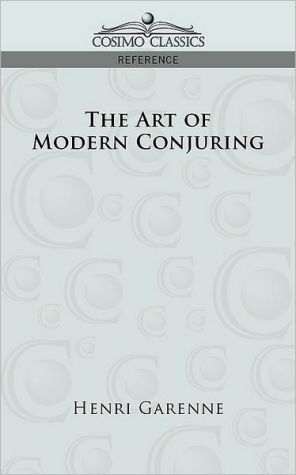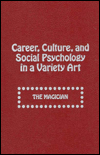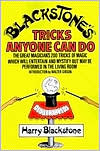The Art of Modern Conjuring
The reader, if he follows diligently the instructions that I will give him, will be able in a short time to astonish his numerous friends with his acquired knowledge. Of course, he cannot expect to be a Robert Houdin... in a week, a month, or even year, because a wizard is not to be made in a day.\ -from the Introduction\ From the basics of palming coins and pretending to shuffle cards to the sophisticated trickery of convincing ladies to float in midair and spirits to manifest themselves,...
Search in google:
The reader, if he follows diligently the instructions that I will give him, will be able in a short time to astonish his numerous friends with his acquired knowledge. Of course, he cannot expect to be a Robert Houdin... in a week, a month, or even year, because a wizard is not to be made in a day.-from the IntroductionFrom the basics of palming coins and pretending to shuffle cards to the sophisticated trickery of convincing ladies to float in midair and spirits to manifest themselves, this charming book, first published in 1886, is a fascinating guide to the magician's stock in trade: his secrets. As slyly subversive in his day as today's magic tell-alls Penn and Teller, the author reveals:. how to nail a "secretly" chosen playing card to the wall. how to produce a shower of sweets from a borrowed handkerchief. how to produced a dozen babies from a top hat. how to pass an egg into a bottle. how to change a bottle of wine into a vase of flowers. how to "supernaturally" animate a skull. how to read minds. and more!The mysterious "Henri Garenne" has disappeared into history, but his treatise remains a classic of stage magic, required reading for anyone who wishes to amaze audiences with feats of prestidigitation.OF INTEREST TO: magic fans, amateur conjurers
The Art of Modern Conjuring \ \ By Henri Garenne Cosimo \ Copyright © 2006 Henri Garenne\ All right reserved.\ ISBN: 9781596058316\ \ \ The Author's Views and Intentions\ \ Having devoted much time to the study and practice of the art of Conjuring and Illusions, I have determined to write this treatise upon the "dark" art. Conjuring is an art that has been known for many ages; and people were foolish enough to believe in those days, that the performer, or magician, had dealings with a certain dark gentleman whom we will not name. However, people of the present day are getting more enlightened; and although they see something done beyond their ken, yet they know it is only a piece of deception or sleight of hand on the part of the performers.\ \ I have written this work not as an exposure of the art of Conjuring and Magic, but simply to act as a guide for amateurs and young beginners; therefore I shall enumerate many tricks and illusions that my young friends can perform at home amongst their numerous friends. In addition to this, I shall also enumerate those tricks and illusions which demand a larger amount of room, and also require specially constructed apparatus; such tricks the amateur would do well not to attempt, as they are only suitable for performance on a stage. I shall give a description of most of the numerous tricks and illusions as performed by most of the leading "wizards" of the past and present day. I shall also give a detailed account ofmany of the so-called spiritualistic illusions, manifestations, and séances, also a few hints and remarks upon the so-called latest novelty, thought-reading. My intention in these pages is to touch on sleight of hand generally, as well as other more particular and effective tricks and illusions. The reader, if he follows diligently the instructions that I will give him, will be able in a short time to astonish his numerous friends with his acquired knowledge. Of course, he cannot expect to be a Robert Houdin, a Professor Anderson, or a Robert Heller in a week, a month, or even a year, because a wizard is not to be made in a day. And the student will do well to commence the same as in learning the art of music or anything else, and begin at the beginning, with simple things first, and practice with diligence and perseverance until he attains the much coveted dexterity. Simple tricks, if performed neatly, have oftentimes a brilliant effect, and gain more applause from your audience than the performance of some more particular and costly trick.\ \ Rules to Be Remembered\ \ The first rule to be borne in mind is this: Never tell your audience beforehand what you are going to do. If you do so, the chances are that the spectators will then detect how you do such a trick, as their vigilance will be on the alert.\ \ It next follows as a second rule: Never perform the same trick twice before the same audience. The best trick loses half its effect by repetition; besides which, the audience would know precisely what was coming, and would be on the alert to find out at what point you cheated their eyes on the first occasion.\ \ If you get an encore, a little tact will always get you out of your difficulty; and when you have become thoroughly proficient in the art, you will then be able to find many ways of altering the working of a certain trick, in the variation and combination of ways and means of causing a given article to vanish and of reproducing a given article.\ \ The student must cultivate the art of talking, from the first commencement, and to be able to use his eyes and hands independently, because in working or doing any trick, the performer must be talking to his audience, looking at them steadfastly, never once casting his eyes down toward his hands. I might say that the most effective way for the student to practice is to stand in front of a looking glass, where he can form a better idea if a looker-on can detect what he is doing.\ \ This he will find most particularly useful in practicing card tricks.\ \ Before proceeding to the practice of the art of Magic, a short description is necessary of a few of the appliances which are in constant use and requisition by every one who practices the art of Conjuring.\ \ Of these, first in order comes -- \ \ The Magician's Wand\ \ This is a light rod, about fifteen inches long and three-quarters of an inch in diameter. It may be of any material, but is generally made of ebony. It is decorated in any manner the owner may fancy. To the uninitiated, it may appear a mere piece of affectation on the part of the performer; but such is not the case. Without his wand, a magician would be at a loss on many occasions what to do, because the wand affords a plausible pretext for many necessary movements, which would, without its use, appear very awkward, and thereby sharpen the vigilance of the audience at, perhaps, the most critical portion of the trick. If the performer wishes to hold anything concealed in his hand, by holding the wand in the same hand, he can keep it closed without the slightest suspicion. If it is necessary, as frequently happens, to walk to the table to get rid of, or to pick up, any desired article, the mere taking up or putting down of the wand affords the required opportunity.\ \ I should always advise the student to cultivate the habitual use of the wand. With its use the performer can, according to his professed character, cause a magical transformation, by using it, and touching daintily the articles he is supposed to be operating on, thus leading his audience to believe that such a change did actually take place at that particular moment, instead of having been secretly effected at an earlier period.\ \ The Magician's Tables\ \ It is generally the practice to have three tables when performing, one center table and two smaller or side tables. Of course it is not necessary to use the three, as in many instances the performer can do all he requires with the one center table.\ \ There are many kinds of conjuring tables in use, being specially made, and fitted with various concealed traps, pistons, etc. This kind of table is, however, chiefly used for stage performances. For the student, however, who intends starting only with simple and minor tricks, an ordinary table will do, but with this difference, that the legs should be six or eight inches longer than the legs of an ordinary table. The required height could be obtained by putting firm blocks of the necessary height, with a depression made in the top of each of them in which to put the bottom of the table legs, thus making it firm and preventing it from slipping off the blocks.\ \ At the back of the table, it is necessary to have a shelf or ledge fixed, this shelf to be six or eight inches in width, extending nearly from end to end.\ \ Such a shelf could be made portable, to enable the performer to fix it on any table, by means of short thumbscrews.\ \ This shelf is technically known as the servante, and should be covered with a thick woolen cloth or green baize, to deaden the sound of anything falling upon it. When it is not possible to fix a servante, a table having a drawer in one side can be used, the side with the drawer in to be away from the audience, this upon occasion will make a tolerably fair servante.\ \ Over this table should be thrown a small cover, fastened at the back edge with a couple of drawing pins, to prevent its slipping. This cloth should hang down a few inches from the top of the table, enabling the audience to look right under the table. This class of table will do very well for amateurs to use, until they get more initiated into the art of Stage Conjuring, in which case they would require to use proper conjuring tables or tables fitted with a combination of traps, pistons, etc., and such can be had either with ornamental fronts or plain. As regards the two small side tables, or guéridons, or stands for candles, lamps, etc., they are made either with plain tops, or can be made fitted with traps, similar to the center table; if the latter, they are very useful for getting rid of any article or articles in the course of working a trick. Many performers use only plain tables, and they are either brought forward or put back, to assist in the period of working some tricks, as they are much more convenient to use than the larger table. The height of the center table, to an extent, depends upon the height of the performer; the shelf or servante at the back of the center table should be just high enough from the flooring to be on a level with the hands of the performer when his arms hang by his side; and the top of the table should be about six inches higher than this. The performer will find that this will enable him to pick up or put down any article without stooping or altering the position of his body in the least.\ \ One of the first tasks of the novice should be to acquire the power of quickly picking up or laying down any article on the servante without any corresponding motion of the body, and especially to abstain from looking down at his hands, because if the audience once suspects that he has a secret receptacle behind his table, half the novelty of his tricks is thenceforth destroyed.\ \ A small oblong box, well padded with wadding, or half filled with bran, should be placed on the servante: it will be found useful in getting rid of small articles, such as eggs, oranges, coins, rings, etc.; and they can be dropped into the box without causing the slightest sound, or attracting attention. Be particular, in setting the table ready before commencing a performance, not to have a lot of unnecessary articles on the table, as it looks unsightly; and the performer must place the various articles he will require on the servante in such position that he can walk up to the table and pick such articles up without once looking down. With a little practice, the performer will be able to do this easily and without attracting the slightest attention.\ \ The next most important thing is -- \ \ The Magician's Dress\ \ It was formerly the custom of conjurers to wear a long flowing robe, embroidered with strange figures. This style of dress allowed the performer to conceal a quantity of large-sized articles. However, that style of dress has now been long discarded, and the costume of a magician of the present day is an ordinary evening dress suit. Of course the effect is materially heightened, on account of the comparative scantiness of such a costume, which appears to allow of no space for concealing various articles. In reality, this dress is specially provided with large and deep pockets, called profondes, for the reception of concealed articles. In the tails of the coat are placed two large pockets, from six to eight inches in depth and about eight inches across, with the opening slanting slightly downwards from the center to the side. The performer can thus, by merely dropping his hand to his side, let fall any article into the profonde on that side, or take anything from thence in a like manner; the action is so natural that the audience never observe it, more especially if the performer slightly turns that side of his body away from the audience. In addition to this, some performers have a deep pocket made on the inside of the breast of the coat on either side, being made according to the fancy of the wearer; such pockets are especially useful in producing globes of goldfish.\ \ In the trousers a couple of small pockets (styled pochettes) are made, one behind each thigh. These are more generally used for production only. Other pockets can also be added, according to the fancy of the wearer, but the above generally suffice.\ \ As regards the waistcoat, it will be found a very great convenience to have an elastic band stitched around the lower edge of the waistcoast; this makes it press tightly round the waist, and such articles as cards or a handkerchief may be slipped under, without the least fear of their falling.\ \ If the performer has his dress made and fitted as above, he will be able to produce and get rid of, instantaneously, many articles which are too large to be palmed; and with a slight turn of his body he can get rid of an article with one hand, and produce the substitute with the other.\ \ Talking to the Audience\ \ Before concluding these introductory remarks, I may add that it is most desirable for the performer to be able to use his tongue fluently and talk glibly at all times, because it takes off the attention of the audience from his movements. Thus the performer is enabled, while he is talking, to effect the various changes he requires. It is not well to represent that you intend doing such-and-such great tricks, but to tell your audience that you will amuse them with a few simple tricks; and you will invariably find that the audience are more astonished, because, expecting to see something simple, it strikes them all with wonder and amazement when a more elaborate trick is performed. With this advice, I shall draw my introductory remarks to a close, and get on to the more serious matter of Tricks and Illusions. \ \ \ \ Continues... \ \ \ \ Excerpted from The Art of Modern Conjuring by Henri Garenne Copyright © 2006 by Henri Garenne. Excerpted by permission.\ All rights reserved. No part of this excerpt may be reproduced or reprinted without permission in writing from the publisher.\ Excerpts are provided by Dial-A-Book Inc. solely for the personal use of visitors to this web site. \ \



